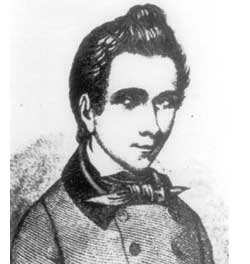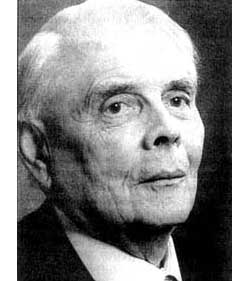Before we can even attempt to describe the adelic description of the Bost-Connes Hecke algebra and its symmetries, we’d probably better recall the construction and properties of adeles and ideles. Let’s start with the p-adic numbers $\hat{\mathbb{Z}}_p $ and its field of fractions $\hat{\mathbb{Q}}_p $. For p a prime number we can look at the finite rings $\mathbb{Z}/p^n \mathbb{Z} $ of all integer classes modulo $p^n $. If two numbers define the same element in $\mathbb{Z}/p^n\mathbb{Z} $ (meaning that their difference is a multiple of $p^n $), then they certainly define the same class in any $\mathbb{Z}/p^k \mathbb{Z} $ when $k \leq n $, so we have a sequence of ringmorphisms between finite rings
$ \ldots \rightarrow^{\phi_{n+1}} \mathbb{Z}/p^n \mathbb{Z} \rightarrow^{\phi_n} \mathbb{Z}/p^{n-1}\mathbb{Z} \rightarrow^{\phi_{n-1}} \ldots \rightarrow^{\phi_3} \mathbb{Z}/p^2\mathbb{Z} \rightarrow^{\phi_2} \mathbb{Z}/p\mathbb{Z} $
The ring of p-adic integers $\hat{\mathbb{Z}}_p $ can now be defined as the collection of all (infinite) sequences of elements $~(\ldots,x_n,x_{n-1},\ldots,x_2,x_1) $ with $x_i \in \mathbb{Z}/p^i\mathbb{Z} $ such that
$\phi_i(x_i) = x_{i-1} $ for all natural numbers $i $. Addition and multiplication are defined componentswise and as all the maps $\phi_i $ are ringmorphisms, this produces no compatibility problems.
One can put a topology on $\hat{\mathbb{Z}}_p $ making it into a compact ring. Here’s the trick : all components $\mathbb{Z}/p^n \mathbb{Z} $ are finite so they are compact if we equip these sets with the discrete topology (all subsets are opens). But then, Tychonov’s product theorem asserts that the product-space $\prod_n \mathbb{Z}/n \mathbb{Z} $ with the product topology is again a compact topological space. As $\hat{\mathbb{Z}}_p $ is a closed subset, it is compact too.
By construction, the ring $\hat{\mathbb{Z}}_p $ is a domain and hence has a field of fraction which we will denote by $\hat{\mathbb{Q}}_p $. These rings give the p-local information of the rational numbers $\mathbb{Q} $. We will now ‘glue together’ these local data over all possible prime numbers $p $ into adeles. So, forget the above infinite product used to define the p-adics, below we will work with another infinite product, one factor for each prime number.
The adeles $\mathcal{A} $ are the restricted product of the $\hat{\mathbb{Q}}_p $ over $\hat{\mathbb{Z}}_p $ for all prime numbers p. By ‘restricted’ we mean that elements of $\mathcal{A} $ are exactly those infinite vectors $a=(a_2,a_3,a_5,a_7,a_{11},\ldots ) = (a_p)_p \in \prod_p \hat{\mathbb{Q}}_p $ such that all but finitely of the components $a_p \in \hat{\mathbb{Z}}_p $. Addition and multiplication are defined component-wise and the restriction condition is compatible with both adition and multiplication. So, $\mathcal{A} $ is the adele ring. Note that most people call this $\mathcal{A} $ the finite Adeles as we didn’t consider infinite places, i will distinguish between the two notions by writing adeles resp. Adeles for the finite resp. the full blown version. The adele ring $\mathcal{A} $ has as a subring the infinite product $\mathcal{R} = \prod_p \hat{\mathbb{Z}}_p $. If you think of $\mathcal{A} $ as a version of $\mathbb{Q} $ then $\mathcal{R} $ corresponds to $\mathbb{Z} $ (and next time we will see that there is a lot more to this analogy).
The ideles are the group of invertible elements of the ring $\mathcal{A} $, that is, $\mathcal{I} = \mathcal{A}^{\ast} $. That s, an element is an infinite vector $i = (i_2,i_3,i_5,\ldots) = (i_p)_p $ with all $i_p \in \hat{\mathbb{Q}}_p^* $ and for all but finitely many primes we have that $i_p \in \hat{\mathbb{Z}}_p^* $.
As we will have to do explicit calculations with ideles and adeles we need to recall some facts about the structure of the unit groups $\hat{\mathbb{Z}}_p^* $ and $\hat{\mathbb{Q}}_p^* $. If we denote $U = \hat{\mathbb{Z}}_p^* $, then projecting it to the unit group of each of its components we get for each natural number n an exact sequence of groups
$1 \rightarrow U_n \rightarrow U \rightarrow (\mathbb{Z}/p^n \mathbb{Z})^* \rightarrow 1 $. In particular, we have that $U/U_1 \simeq (\mathbb{Z}/p\mathbb{Z})^* \simeq \mathbb{Z}/(p-1)\mathbb{Z} $ as the group of units of the finite field $\mathbb{F}_p $ is cyclic of order p-1. But then, the induced exact sequence of finite abalian groups below splits
$1 \rightarrow U_1/U_n \rightarrow U/U_n \rightarrow \mathbb{F}_p^* \rightarrow 1 $ and as the unit group $U = \underset{\leftarrow}{lim} U/U_n $ we deduce that $U = U_1 \times V $ where $\mathbb{F}_p^* \simeq V = { x \in U | x^{p-1}=1 } $ is the specified unique subgroup of $U $ of order p-1. All that remains is to determine the structure of $U_1 $. If $p \not= 2 $, take $\alpha = 1 + p \in U_1 – U_2 $ and let $\alpha_n \in U_1/U_n $ denote the image of $\alpha $, then one verifies that $\alpha_n $ is a cyclic generator of order $p^{n-1} $ of $U_1/U_n $.
But then, if we denote the isomorphism $\theta_n~:~\mathbb{Z}/p^{n-1} \mathbb{Z} \rightarrow U_1/U_n $ between the ADDITIVE group $\mathbb{Z}/p^{n-1} \mathbb{Z} $ and the MULTIPLICATIVE group $U_1/U_n $ by the map $z \mapsto \alpha_n^z $, then we have a compatible commutative diagram
[tex]\xymatrix{\mathbb{Z}/p^n \mathbb{Z} \ar[r]^{\theta_{n+1}} \ar[d] & U_1/U_{n+1} \ar[d] \\
\mathbb{Z}/p^{n-1} \mathbb{Z} \ar[r]^{\theta_n} & U_1/U_n}[/tex]
and as $U_1 = \underset{\leftarrow}{lim}~U_1/U_n $ this gives an isomorphism between the multiplicative group $U_1 $ and the additive group of $\hat{\mathbb{Z}}_p $. In case $p=2 $ we have to start with an element $\alpha \in U_2 – U_3 $ and repeat the above trick. Summarizing we have the following structural information about the unit group of p-adic integers
$\hat{\mathbb{Z}}_p^* \simeq \begin{cases} \hat{\mathbb{Z}}_{p,+} \times \mathbb{Z}/(p-1)\mathbb{Z}~(p \not= 2) \\ \hat{\mathbb{Z}}_{2,+} \times \mathbb{Z}/2 \mathbb{Z}~(p=2) \end{cases}$
Because every unit in $\hat{\mathbb{Q}}_p^* $ can be written as $p^n u $ with $u \in \hat{\mathbb{Z}}_p^* $ we deduce from this also the structure of the unit group of the p-adic field
$\hat{\mathbb{Q}}_p^* \simeq \begin{cases} \mathbb{Z} \times \hat{\mathbb{Z}}_{p,+} \times \mathbb{Z}/(p-1)\mathbb{Z}~(p \not= 2) \\ \mathbb{Z} \times \hat{\mathbb{Z}}_{2,+} \times \mathbb{Z}/2 \mathbb{Z}~(p=2) \end{cases} $
Right, now let us start to make the connection with the apparently abstract ringtheoretical post from last time where we introduced semigroup crystalline graded rings without explaining why we wanted that level of generality.
Consider the semigroup $\mathcal{I} \cap \mathcal{R} $, that is all ideles $i = (i_p)_p $ with all $i_p = p^{n_p} u_p $ with $u_p \in \hat{\mathbb{Z}}_p^* $ and $n_p \in \mathbb{N} $ with $n_p=0 $ for all but finitely many primes p. Then, we have an exact sequence of semigroups
$1 \rightarrow \mathcal{G} \rightarrow \mathcal{I} \cap \mathcal{R} \rightarrow^{\pi} \mathbb{N}^+_{\times} \rightarrow 1 $ where the map is defined (with above notation) $\pi(i) = \prod_p p^{n_p} $ and exactness follows from the above structural results when we take $\mathcal{G} = \prod_p \hat{\mathbb{Z}}_p^* $.
This gives a glimpse of where we are heading. Last time we identified the Bost-Connes Hecke algebra $\mathcal{H} $ as a bi-crystalline group graded algebra determined by a $\mathbb{N}^+_{\times} $-semigroup crystalline graded algebra over the group algebra $\mathbb{Q}[\mathbb{Q}/\mathbb{Z}] $. Next, we will entend this construction starting from a $\mathcal{I} \cap \mathcal{R} $-semigroup crystalline graded algebra over the same group algebra. The upshot is that we will have a natural action by automorphisms of the group $\mathcal{G} $ on the Bost-Connes algebra. And… the group $\mathcal{G} = \prod_p \hat{\mathbb{Z}}_p^* $ is the Galois group of the cyclotomic field extension $\mathbb{Q}^{cyc} $!
But, in order to begin to understand this, we will need to brush up our rusty knowledge of algebraic number theory…
4 Comments Even if you don’t know the formal definition of a profinte group, you know at least one example which explains the concept : the
Even if you don’t know the formal definition of a profinte group, you know at least one example which explains the concept : the  These groups come equipped with a natural topology : the
These groups come equipped with a natural topology : the